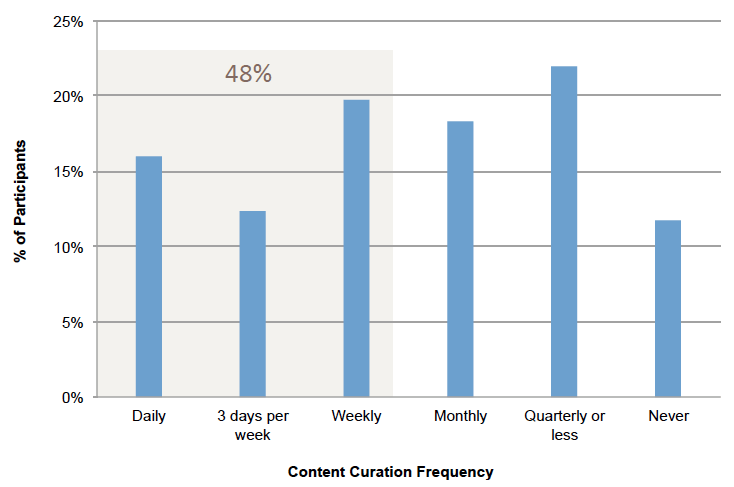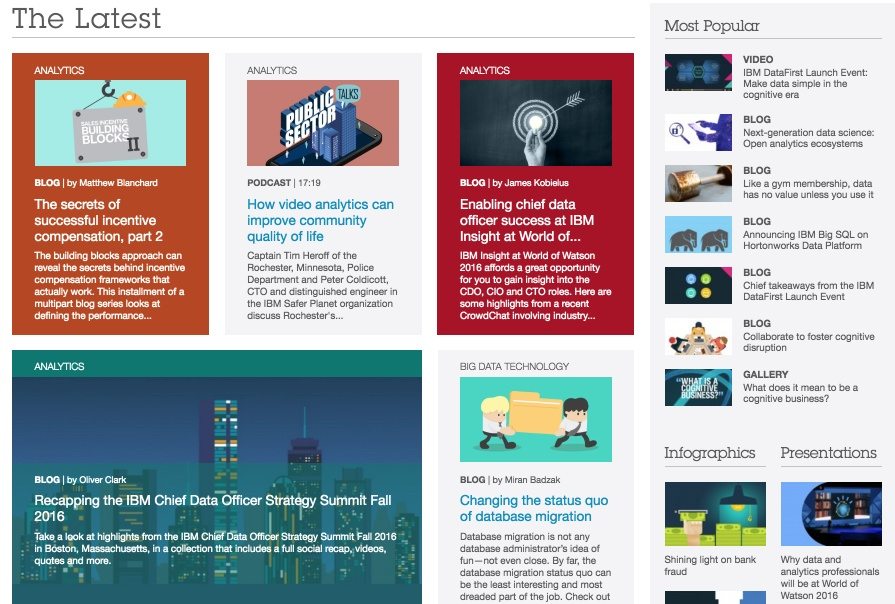Alongside original content, content curation is a key aspect of any content marketing initiative. When done right, curation can improve your SEO, establishes your credibility as a thought leader, supports lead generation, streamlines lead nurturing, and complements social media and blogging.
Most importantly, if you don’t have the time, staff or budget to publish enough great (or even good) content — content curation is an economical and efficient way to fill your content calendar. So let’s be clear about what curation is, and is not.
What content curation is not:
Content curation is not content farming, licensed content, scraping, or aggregation. These can be defined as:
- Content farming: generating large amounts of content that is heavily laden with keywords, specifically designed for pickup by search engine algorithms to generate advertising revenue through reader pageviews. This content is not written for a human audience to consume.
- Licensed content: where you pay an author to get their permission to republish their original content in its entirety on your site in order to provide a seamless reading experience, keep readers on your site, or not worry about fair-use or how much content you take.
- Scraping: copying content from other websites and publishing it on your own site as if it were your own original or licensed content.
- Aggregation: bringing together articles on a similar topic, and grouping them together without additional commentary or annotation. Aggregation is done by a machine or a software technology primarily, such as Google Reader or Google Alerts, ensuring a high likelihood the content may be irrelevant.
Defining content curation
Content curation is when an individual (or team) consistently finds, organizes, annotates, and shares the most relevant and highest quality digital content on a specific topic for their target market.
Notice there are five aspects to this definition. These are the key elements to remember about content curation:
- It is not an automated process computed by algorithms. One or more people are involved with each person adding their own respective insights to the topic.
- This is an ongoing activity, not a one-time event.
- Not only are you finding and sharing links to content produced by third party sources, you are also organizing and annotating the information — and highlighting why key points are important.
- Be sure to include your point-of-view or editorial perspective. When doing this, be discerning, discriminative, and selective.
- As an editor, curate content with your audience in mind. Focus on their questions, their issues, and what they most value.
How often should you curate? While the answer varies depending on your audience size and the amount of your other communications, a majority of marketers are curating at least once a week.
For example, Curata surveyed 500+ of its American and global customers in 2014, asking the following question:
How often do you curate/share content from 3rd party sources such as
blogs, social media, industry publications or news sites with your customers
and/or prospects?

Curating the right content
When it comes to curating content into a collection, the sum is greater that the individual parts. More content does not necessarily give a collection greater value. Rather, you need to present your audience with high quality material that is useful and relevant to them.
The following is a good strategy to follow when deciding how much content to curate, and which types are recommended:
- Curate content from a wide variety of sources, including trade publications, blogs, social media updates, news outlets, video streaming services and any other source as long as they are highly authoritative.
- Organize your curated results into categories that appeal to your target audience. For example, Curata organizes its curated content into categories such as: best practices, latest news, events, trends, case studies, and so on.
- Ensure the categories are visible as metadata to search engines for SEO.
- Distribute and share the results of your curation efforts across multiple digital channels, including websites, social media feeds, blogs, mobile app experiences, and email newsletters.
In its 2016 Content Marketing Staffing & Tactics Barometer, Curata asked 1,000+ marketers in America and around the globe:
What percentage of companies are curating content or outsourcing created content?

Leading content marketers curate and outsource a significant amount of their content. Based on our research, Curata advises creating 65 percent of your own content, curating 25 percent, and syndicating 10 percent. This means that leading marketers outsource approximately one-third of the content they publish.
Add value with curation
Like a museum curator selecting significant artifacts for an exhibition, add value by presenting the best content you can find, and organize a content collection in ways that make sense to your target audience (similar to the point explained in the previous section).
How can you add value to create a curated collection? Once you select items to be included in a collection, there are three value-adding activities:
- Recap and summarize each item within a curated collection. In addition to adding the link, you can even quote (with attribution) a small snippet of the original asset, provided it falls within ‘fair use’ parameters.
- Contextualize the article, post, or snippet for your target audience — explaining its significance. Add your own title and/or thumbnail, utilizing terms familiar to your audience. Also, add annotations or an introduction that explains the article’s relevance to your particular readers.
- Add a call-to-action and identify the next steps for your target audience. This is a good place to link to a relevant ebook or blog post to bring readers back to your original content and owned properties.
Remember, your secret sauce is the quality, not the quantity of the content you present to your target audience.
IBM case study
IBM Marketing focuses on four key areas for its customers: social, mobile, cloud, and big data. In 2013 it created a central hub focused on these key topics, the IBM Big Data & Analytics Hub. Initially, the Hub started off as a site that wasn’t refreshed very often, had low engagement, and only featured IBM’s writers and thinkers.
However, during part of a site rebuild, Matt Carter, Program Director, IBM Digital Marketing, Big Data & Analytics and his marketing team added an “Around the Web” tab. The problem was, they didn’t have the time or resources to scour the web for items that were, “objective, balanced, and vendor neutral,” according to Carter.
Instead, the site needed to be more informational and educational — rather than promotional — for IBM to be a credible resource. So the team gathered intelligence about popular search terms, topics, and themes related to big data and analytics to find stories interesting and relevant to their audience.
The IBM team then turned to content marketing software to find, organize, annotate, and share this information via a dashboard. This allowed the Big Data & Analytics social sites to be populated with content leading back to the Hub. The Hub’s readers now find constantly refreshed content from the best minds in the industry and can engage in a thriving ecosystem of conversations.

Now, the Hub complements IBM.com, feeding the top of the sales funnel with thought leadership content and delivered impressive numbers within a year: a 291% increase in social referral traffic, a 269% lift in time on site, and a 151% expansion in organic search. The site has also been integral in identifying and securing outside contributors and influencers for other big data and analytics programs.
The power of content curation
When done right, content curation leverages the power of third-party content and benefits everybody: you the curator, your target audience, and the content creators. It’s a valuable way to economically increase your content output, incorporate more diverse perspectives, and build credibility as an unbiased thought leader.
Check out some of the top content curation tools every marketer should use and for a complete guide to setting up a content curation program, download The Ultimate Guide to Content Curation.
About the author
Pawan Deshpande is the founder and CEO of Curata. His work at Curata has been recognized through the 2010 Boston Business Journal’s 40 under 40 Award, and through the Massachusetts Technology Leadership Council’s 2012 Sales & Marketing Technology of the Year Award. Pawan has held software engineering positions at Microsoft, Google and other startups where he was awarded patents in social networking and machine transliteration areas.
Pawan is also a blogger for Content Curation Marketing, Content Marketing Institute, CMO.com, Forbes, Marketing Profs, and other technology and marketing publications.

See the Instapage Enterprise Plan in Action.
Demo includes AdMap™, Personalization, AMP,
Global Blocks, heatmaps & more.
